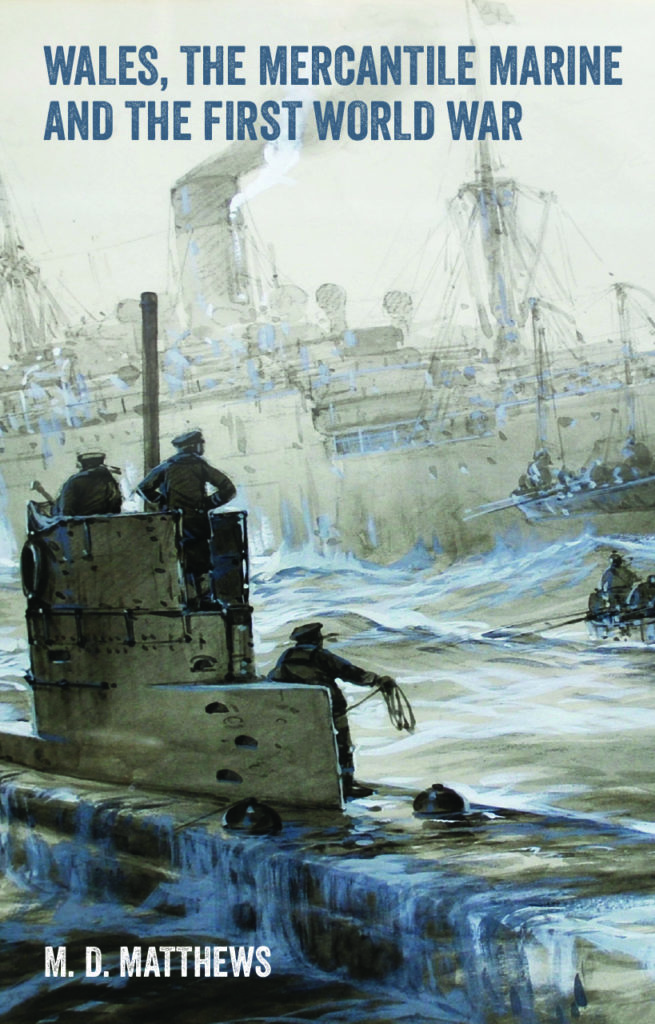
The cover illustration for my book, Wales, the Mercantile Marine and the First World War, is taken from a depiction by a popular German marine artist of the following First World War encounter between a U-boat and a Welsh merchant vessel.
On 30 January 1915 Lord Penrhyn’s newest steamer, the Beaumaris-registered Linda Blanche 530 GRT (1914), with ten Welsh crew (and the skipper’s fox-terrier), was sailing from Manchester for Belfast with general cargo that included glazed floor tiles. The steamer was stopped some 18 miles north-west of Liverpool Bar Light Vessel by the German U-boat SM U-21, commanded by Otto Hersing. The ship’s papers were inspected and the crew were given ten minutes to get into the lifeboats. The Linda Blanche was then sunk by bombs placed on the bridge and in the forecastle. The crew, after rowing for an hour and a half through rough seas were picked up by the trawler Niblick, and landed at Fleetwood. The men comprised: John Ellis, master from Bangor; Robert D. Morris, mate from Barmouth; four able seamen, William Williams from Anglesey, Peter Dob and Thomas Lillie, both from Port Dinorwic, and John D. Hughes from Porthmadog; Thomas J. Hughes the 1st engineer from Holyhead; William Paxton the 2nd engineer who was from Newport; and two firemen from Bangor, Alfred Thomas and John Hughes.
This attack was commemorated by the German artist and illustrator Willy Stöwer in his 1915 painting Kaperung und Versenkung des Englischen Handelsdampfer Linda Blanche. The picture shows the U-boat abiding by ‘cruiser’ or ‘prize’ rules for attacks on civilian shipping, and allowing the crew of the ship to take to the boats, prior to the sinking. The artist who produced this striking image was the son of a merchant sea captain and prior to becoming a professional artist, Stöwer had worked in the engineering offices of several German shipbuilders. He would later become the favourite marine painter of the Kaiser. Between 1892 and 1929, he created approximately 900 black-and-white and 335 colour illustrations. His representation of the sinking of the Titanic became iconic. In 1917 some of Stower’s naval scenes were reproduced in monochrome on Wohlfahrts-Kartes charity cards which were sold to help support wounded U-boat crew members and the families of the deceased.
This image however is far from a true depiction of the event. The Linda Blanche was a small and unimpressive coaster, a mere 27 ft from stem to stern and with 10ft beam, it was quite different from the steamer shown in the painting. By contrast, SM U 21 was 210 ft long and 20 ft wide, with complement of four officers and twenty-five men. One of the first diesel engine U-boats to enter service, on 5 September 1914 under the command of Hersing, SM U-21 became the first submarine to sink a ship with a self-propelled torpedo when the cruiser HMS Pathfinder was destroyed off the Firth of Forth. Out of 270 men on board, there were only 20 survivors.
Other than misrepresenting the relative size of the Linda Blanche, the other glaring omission from this depiction is the conspicuous absence of the 88 mm SK L/30 deck gun with which SM U-21 was fitted. The deck gun was however specifically mentioned in the report of events carried in the North Wales Chronicle on 5 February 1915:
From their stories it appeared that the Linda Blanche was steaming about ten knots on Saturday about half an hour after mid-day, when the boy called out, ‘Here’s a submarine’. All hands rushed joyously to the side, thinking to see a British submarine, but were astounded to perceive about a ship’s length off a submarine showing the German flag and with a wicked-looking gun on deck aft mounted on a swivel. Through a megaphone came the command in excellent English to stop, an order at once obeyed.
The gun could be fired at a rate of 10 rounds-per-minute and had a maximum range of nearly 4 miles. The dilemma faced by a civilian master in a situation where he stood to lose his ship regardless of his actions, was the difficult choice between his primary responsibilities for the safety of his crew, passengers, and obligations to the owners on the one hand, and the exhortations of the Admiralty to evade capture on the other.
The report of these events in the Cambrian News and Merionethshire Standard of 5 February 1915 was probably one of the last news stories of the war featuring U-boats that would paint the Germans in a good light. The Linda Blanche having been stopped:
Several German officers went aboard, and in perfect English instructed the captain to have the boats lowered and the crew cleared away in ten minutes. This order was promptly carried out, and sailors from the submarine fixed a mine in the forecastle and one on the bridge, and by these means the vessel was blown up. The Germans told the crew that there were some trawlers in a certain direction and if they would make that course they would be picked up. … Members of the crew state that they were treated like gentlemen by the crew of the submarine, and were presented with a box of cigars. The officers of the submarine also shook hands with the captain of the steamer. On being told that the steamer was only six months’ old the officers of the submarine … said “We are very sorry, but war is war.”
This crew were lucky, as a few days after the sinking, the German policy of unrestricted submarine warfare was publicly announced.
Mark David Matthews is a maritime historian and freelance researcher. He is currently working on a book exploring the maritime links between Wales and the Maghreb 1551–1912.


